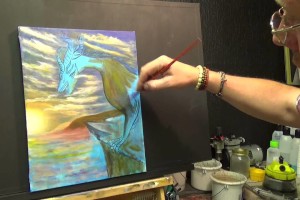The prospect of painting with acrylics can be daunting for beginners, perhaps because the technique is still relatively young itself. Acrylics have only been around for some 60s years and so perhaps some of us are not as acquainted with them as we are watercolour and oil paints. Novices need not be afraid of this new branch of painting however, as painting with acrylic can produce magnificent results in very short periods of times.
This guide is an introduction to acrylics and an insight into how new painters can explore this wonderful new world.
Brushes
The first brushes in your arsenal should be a hog hair or other stiff bristled and a small, round bush with softer bristles. The former is for thicker acrylics and the latter for watercolour effects. A size 10 filbert brush is a great size for a first brush as it has a narrow tip for detail, but a thicker base that can be used for larger or broader strokes.
As you gain more experience you’ll certainly want to invest in more brushes in order to try out new strokes and techniques. There really is a plethora available on the market so start with a small collection and build it up as you try new brushes out. Visit www.handyhippo.co.uk to start your collection.
Cleaning your brushes is imperative as the acrylic attacks the bristles and can make short work of even the newest of brushes. Wash them under the tap, working out the last drops of acrylic with your fingers.
Paints
Acrylic is a water based paint, which means it can be thinned out with water as well as paint mediums. Whilst the former is cheaper, it can adversely affect the luminosity of the paint so consider investing in some paint medium as well as a good set of paints.
There are a number of paint brands, each consisting of a range of colours. As you might expect, some are more expensive than others although it is worth mentioning that you usually get what you pay for with acrylic paints. Invest in a base set of colours to begin with and, like with the brushes, build up your collection as you go along. To begin with invest in a red, blue, yellow and a green alongside a black and a white for outlines and detail.
Palettes and Accessories
Due to the fast drying nature of acrylic paints a special palette must be used. These are lightweight, durable and designed to keep the paint wet for as long as possible. A set of disposable palettes is a great investment for those new to acrylic paints as they are cheap and easy to throw away.
When using a palette ensure you are sparing as even with the wet palettes, the acrylic paints will still dry extremely quickly. Take care not to waste paint and only add on what you need for a section or part as once dry, acrylic paint cannot be re-used.
Other accessories that you may find useful include a pencil and eraser (for sketching out preliminary designs), kitchen roll and sponges (for creating a textured effect and mopping up spills) and a hairdryer (to speed up the drying process).
Canvas
Whilst purists might insist on priming and stretching their own canvases, the simplest thing to do as a beginner is buy ready-primed canvas upon which you can paint out of the packet. It will save you a considerable amount of time and money.
Linen or cotton duck canvas is the most affordable and available canvas for acrylic painting although, if you prefer, thick watercolour paper (thicker than 300gsm) or acrylic paper is also fine.
When painting if the canvas or painting begins to sag or cockle stop working and let the paint dry. Turn the canvas over and place it facing down, wet the back and apply an even pressure across the back for several hours (using some heavy books on top of a board is a good way to do this) until it has dried.
Once you have all this gear it is time to get started! You can paint using acrylics using all manner of strokes and techniques. Use lots of water in order to keep the acrylics wet and experiment with a variety of stroke sizes to find your forte!




